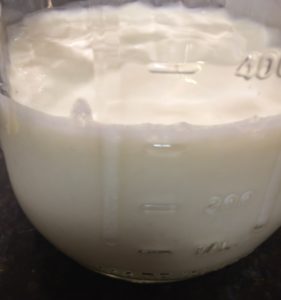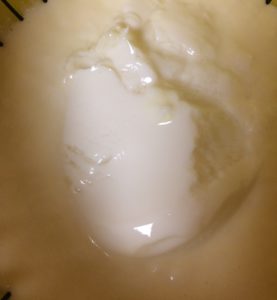 Kefir is an amazing living food that provides multiple benefits especially when ingested every day. Kefir is known to play a curative role in diabetes, cancer, autism, gastritis, IBS, arthritis, and many more. In fact regularly ingesting kefir might be the single most beneficial thing you can do to ensure wellness!
Kefir is an amazing living food that provides multiple benefits especially when ingested every day. Kefir is known to play a curative role in diabetes, cancer, autism, gastritis, IBS, arthritis, and many more. In fact regularly ingesting kefir might be the single most beneficial thing you can do to ensure wellness!
Kefir has the benefits of a pro-biotic since it is rich in vitamins, minerals and polysaccharides, with a diversity of bacteria, yeast and mould which are beneficial to the human micro-biome.
Kefir provides over 70 different pro-biotic species which keep harmful bacteria in check, help bring healing to the gut, and enhance immune function. Even people who are lactose intolerant are able to consume kefir because the live organisms consume the lactose leaving it 97% lactose free.
Making kefir is simple – far easier than making yogurt – but you can use it in all the same ways as yogurt, or just drink it straight to make sure you get the daily benefits. Add to soup, stews, waffles, breakfast, salad dressings, etc.
Your kefir grains are often dehydrated for travel and delivery.
- To revitalize your kefir grains, place in a glass jar and pour in milk – leaving about a 1 inch space at the top. Cover with a piece of paper towel held by a rubber band. Choose the size of jar based on the amount of kefir you desire. A bigger jar of milk will take longer than a smaller jar.
- Leave the jar sitting on the kitchen counter. Kefir is ready when you shake the jar and it jiggles. The first batch from dried grains may take slightly longer, but generally kefir is ready in 24 – 36 hours.
- If you leave kefir for too long – several days – it can separate into ‘curds’ and ‘whey’. It is still fine to consume, just mix. Or if you like it thick you can pour off the whey, or use it in soup or baking, and have a thick creamy kefir.
- Once kefir is firm you can remove the grains and begin your next batch.
 To remove the grains you can try with a plastic fork, simply stir around and see if you find the firm kefir grains. This works if the grains are near the top. Other times it is more difficult to find and you need to work the kefir through a plastic Place a large funnel into a clean glass jar then put the plastic colander on top. Pour in the kefir in batches and use a spatula to push it through the holes. You will know when you find the grains because they will not go through the holes!
To remove the grains you can try with a plastic fork, simply stir around and see if you find the firm kefir grains. This works if the grains are near the top. Other times it is more difficult to find and you need to work the kefir through a plastic Place a large funnel into a clean glass jar then put the plastic colander on top. Pour in the kefir in batches and use a spatula to push it through the holes. You will know when you find the grains because they will not go through the holes! If you don’t have time to strain, but the kefir is firm, place the jar ‘as is’ into the refrigerator. It will be fine for many days like that, until you have a chance to strain it.
If you don’t have time to strain, but the kefir is firm, place the jar ‘as is’ into the refrigerator. It will be fine for many days like that, until you have a chance to strain it.- If you know you are going to be away from home for a week or more, or you just want a bit of a break from making kefir, you want to keep your kefir grains alive. Place the kefir grains in a jar, pour milk just to cover, put on a top and keep it in the refrigerator. It will hibernate. When you are ready to make your next batch of kefir, pour out the milk, rinse the grains in spring/filtered water or fresh milk, then place in a glass jar and start at the top. Never expose your kefir to tap water than contains fluoride.
- When kefir grains have multiplied they will work faster in producing the thick kefir. You can divide the grains, share some of your grains with a friend, add them to smoothies, freeze some in milk, or dry them. To share fresh kefir grains simply put them in a jar of milk, or pure water if they won’t be there for too long. The milk provides food to the living organisms.
- To dry them, after straining rinse with pure water or fresh milk, place them on a piece of parchment paper. It will dry in a few days. Dried kefir grains can safely be mailed in an envelope so you can share with family or friends far away!
Historically, kefir grains originate in the Caucasus Mountains between Russian and Georgia where the local people have consumed kefir and experienced remarkable health throughout history. “The census of 1970, revealed that 5,000 centenarians then lived in the Caucasus.”[1] Because of the beneficial probiotics in kefir, regular “consumption reinforces the intestinal flora, helps with digestion, restores the digestive system and strongly stimulates the immune system.” [2]
Kefir grains were considered part of the family’s wealth and the tribe’s wealth and they were passed on from generation to generation. For centuries the people of the northern Caucasus enjoyed this food without sharing it with anyone else. Other peoples occasionally heard strange tales of this unusual beverage, which was said to have magical properties. Marco Polo mentioned kefir in the chronicles of his travels in the East.[1]
The BIG Bonus!
From my reading, it would seem that homemade kefir made using raw cow’s milk provides a good source of GCMAF, which has been used to treat and heal autism and other serious brain disorders. GCMAF is a harmless and naturally occurring glycoprotein with a profound potential to heal. It is produced in human breast milk and plays a significant role in innate immunity. All higher order animals have this glycoprotein which functions to transport Vitamin D to all the cells in our body, including our immune cells. Lack of this protein causes immune suppression.

Becky Hastings, a wife, mom, grandmother, passionate follower of Jesus, health promoter, breastfeeding counsellor helping moms for 22+ years, and someone who seeks to research, understand and share truth so people can make wise choices in our crazy mixed up, deceived world! Sometimes I share recipes and homespun teaching videos.
[1] Sharla. Kefir – The Mystical Side. Web. 11 Aug. 2017. .
[2] Sekkal-Taleb, Nezha. “Chemical and microbiological composition of Kefir and its natural benefits.” Mediterranean Journal of Biosciences1.4 (2016): 174-83. Web. 11 Aug. 2017. .
 “As high as the heavens are about the earth, so are My thoughts higher than your thoughts and My ways higher than your ways.” Isaiah 55:9
“As high as the heavens are about the earth, so are My thoughts higher than your thoughts and My ways higher than your ways.” Isaiah 55:9



